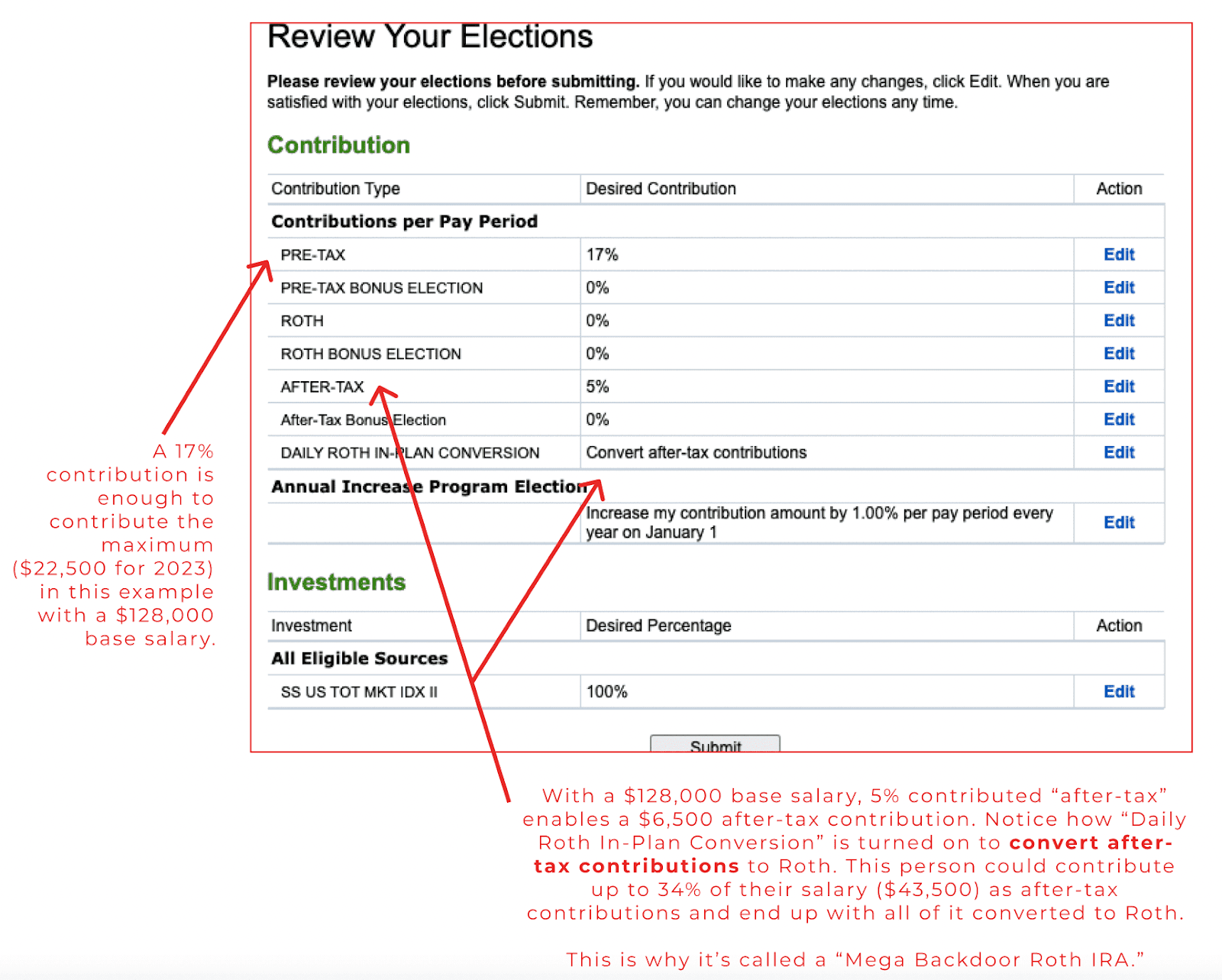How to Contribute Thousands of Extra Roth Dollars Each Year: The Mega Backdoor Roth IRA [2025]
November 6, 2023
The Wealth Planner
The only personal finance tool on the market that’s designed to transform your plan into a path to financial independence.
Get The Planner
Join 200,000 other people interested in money, power, culture, and class.
Subscribe Now
Biggest Finance Newsletter for Women
More than 10 million downloads and new episodes every Wednesday.
The Money with Katie Show
Recommended Posts
If you’re a high earner in the market for an investment strategy that sounds more like a Transformer than a legitimate wealth-building option, then boy, do I have good news for you: The Mega Backdoor Roth IRA might be a contender for your tax-advantaged lineup.
Before we talk about the “how,” let’s talk about the “who.”
Who might be a good candidate for a Mega Backdoor Roth IRA
-
If you’ve already contributed the maximum amount to other tax-advantaged accounts that are a priority to you.
-
If you feel good about how you’re tracking toward goals that require taxable contributions or money in the “medium-term.”
-
And—perhaps obviously, in order for #1 and #2 to be true—a substantial amount of household income or very, very low expenses.
How to do the Mega Backdoor Roth IRA
Ironically, the “Mega Backdoor Roth IRA” is not a Roth IRA at all: It’s technically an “after-tax” contribution to your employer-sponsored 401(k) or 403(b) plan, not to be confused with a Roth contribution, which is much more boring and akin to going through the “front door.”
Unfortunately, not all 401(k) plans allow for after-tax contributions beyond the standard, employee elective deferral of the $23,500 contribution limit (of the four companies I’ve worked for, only two have allowed it).
But in 2025, this strategy allows you to get another $46,500 of Roth dollars in the bank on top of your regular $23,500 contribution to a 401(k) or 403(b).
Bonus, albeit a potentially confusing one: You’re still in the clear to contribute $7,000 per year to a Roth IRA or Backdoor Roth IRA if you want to, as well. Your IRA activity is wholly separate from today’s discussion of juicing your employer plan for all it’s worth.
Why? Because the actual contribution limit for 401(k)s in 2025 is a whopping $70,000.
Here’s how it works:
-
In your company’s retirement portal, you elect to contribute after-tax dollars above and beyond the $23,500 limit.
-
Your plan administrator then (a) converts them to Roth in-plan or (b) permits in-service distributions, allowing you to roll over the funds to a Roth IRA.
…and that’s about it. I pulled an old screenshot from a former employer’s contribution page so you can get a sense for what this might look like on the back end:

Since my base pay at the time was $128,000 and I wanted to contribute a pre-tax $22,500 as well as an after-tax $6,500 (I basically wanted to mirror a regular Roth IRA limit in 2023), my “percentages” were 17% and 5%, respectively. You’ll probably see some language around a “Roth In-Plan Conversion” that’ll ask if you want to “convert after-tax contributions” to Roth, and your answer is a resounding yes.
Candidly, it might be more trouble than it’s worth if you have to manually roll over and convert the after-tax contributions every month, but if your plan converts them to Roth in-plan for you and you can afford it, it’s probably a no-brainer to get a few more tax-advantaged dollars working in your favor.
If you are faced with the manual-only option, some people like to wait until the end of the year to roll over a full year’s worth of their after-tax dollars to their Roth IRAs—but it’s worth noting you’ll pay additional tax at that point on the growth of those after-tax dollars at the point of conversion (assuming they grew, of course).
It’s also worth noting that your employer match counts toward the overall $70,000 limit. If you contribute $23,500 and your employer contributes $10,000 (#goals), your 401(k) bucket technically has $36,500 of “room” left ($70,000 – $23,500 – $10,000 = $36,500).
Importantly, there’s no income limit for this (yet!), so people who earn too much to contribute directly to a Roth IRA (or don’t want to bother with a regular Backdoor Roth IRA) may find this a more seamless way to get both pre-tax and after-tax/Roth exposure in one fell swoop. Now, to find a job with a tech company that offers this Mack Daddy benefit…
Looking for something?
Search all how-to, essays, and podcast episodes.
Explore
While I love diving into investing- and tax law-related data, I am not a financial professional. This is not financial advice, investing advice, or tax advice. The information on this website is for informational and recreational purposes only. Investment products discussed (ETFs, index funds, etc.) are for illustrative purposes only. It is not a recommendation to buy, sell, or otherwise transact in any of the products mentioned. Do your own due diligence. Past performance does not guarantee future returns.
Money with Katie, LLC.
Terms & Conditions | Privacy Policy
This Site Was Built by Brand Good Time